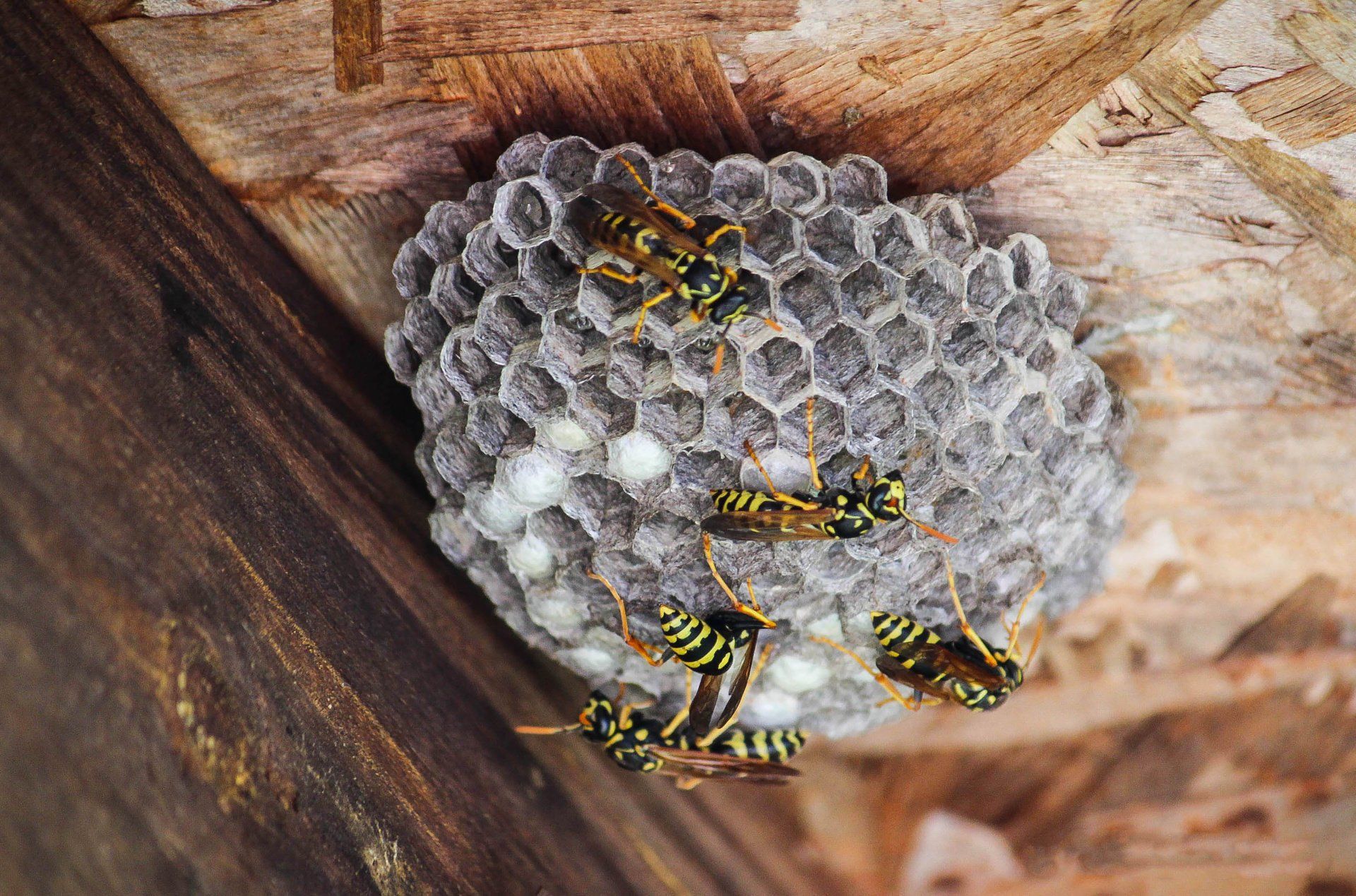Wasp Pest Control
Wasps can pose a serious threat to the safety of your home and family. They are aggressive stinging insects that will swarm if threatened which can be deadly if people with allergies, small children, or elders are stung several times. If you have noticed signs of wasps or their nests starting to develop, be sure to call Griffin Pest Management to get a licensed wasp control specialist out to treat your home.
Call 888-400-9011 For A Free Estimate.
Wasp Control Treatment Services
- Inspection – Finding where the wasp nest is will help the exterminator determine the type of wasp and the best treatment strategy.
- Insecticide Application – Insecticide application is the first step in treatment that helps collapse a wasp colony. This can be done with aerosol, dust, and liquid insecticide.
- Wasp Nest Extermination and Removal – Once a colony has been treated and has started to collapse, the nest can be removed. Be sure to take precautions to ensure safety during removal.
- Exclusion – Wasps will find access to undisturbed areas like wall cavities if entry points are not sealed up. Ensuring that all small access points are closed will keep wasps out.
Why You Should Have Wasps Removed Professionally
Why Choose Griffin?
Qualified Exterminators
Licensed and trained extermination staff that is bonded and insured and undergo background checks to ensure absolute home protection.
Guaranteed Satisfaction
Our service guarantee ensures that if there are any signs of pest activity remaining after treatment, our pest control specialist will return to treat immediately.
Stellar Reputation
We take pride in our family-owned business and are excited to highlight a stellar rating on all review platforms including Yelp and Google.
Immediate Wasp Control
How to Get Rid of Wasp Nests
- Identify the location of the nest and what type of wasp you are dealing with.
- Be sure to wear protective gear to protect you from swarming wasps. This should include covering all exposed skin with thick material in addition to a beekeeper’s helmet and gloves.
- Treat the wasp nest at night when the colony has returned for the evening and are less aggressive. If treatment is done during the day, there will be wasps out searching for food that will rebuild the colony.
- When treating the nest, do not stand directly below the nest. Instead, spray at a 45-degree angle while standing upwind from the spray to avoid insecticide blowback.
- Be sure to monitor wasp activity for at least a day to confirm they do not pose much more of a threat before removing the wasp nest.
Where to Find Wasps Nests?
The location of a wasp nest depends on the type of wasp you are dealing with. Yellow jackets’ nests are typically found underground or in piles of debris while hornets will nest in trees and rotting wood. The species that will generally build a nest somewhere on your home are most likely paper wasps and mud daubers. You will see their nests attached to eaves and overhangs where they are protected from being disturbed. Paper wasps’ nests are made out of paper like cellulose and have a honeycomb structure that is visible from below. Mud daubers nests look like they are made of mud or clay and are clumped against a wall with some openings to allow access. If entry ways into your home are available, some wasps will find their way inside and colonize wall cavities and other spaces that provide ample protection and access to resources. The diversity of wasp species makes dealing with them complicated, which is why having a Griffin wasp control technician come out to treat and remove wasps’ nests is important.
Contact Griffin to Schedule a Wasp Inspection Today
If your home has attracted a wasp colony or you are seeing signs of wasp activity, call Griffin Pest Management to schedule a wasp inspection and nest removal. Our team of licensed and trained exterminators will safely and effectively remove any wasp nests from your home or business, so you no longer have to worry about wasps.
Guaranteed Results
If your home has attracted a wasp colony or you are seeing signs of wasp activity, call Griffin Pest Management to schedule a wasp inspection and nest removal. Our team of licensed and trained exterminators will safely and effectively remove any wasp nests from your home or business, so you no longer have to worry about wasps.
Quick Facts About Wasps
Habits
Paper wasps are semi-social insects. Colonies contain three castes: workers, queens and males. Fertilized queens, which appear similar to workers, lay dormant over winter in protected habitats such as cracks and crevices in structures or under tree bark. In the spring they select a new site and begin to build a nest. Eggs are laid singly in cells and hatch into legless grub-like larvae that develop through several stages (instars) before pupating. In late summer, queens stop laying eggs and the colony soon begins to decline. In the fall, mated female offspring of the queen seek overwintering sites. The remainder of the colony does not survive the winter.
Habitat
Nests are built from wood fiber collected from posts and occasionally from live plant stems, causing some plant damage. This fiber is chewed and formed into a single paper-like comb of hexagonal cells. Nests are oriented downward and are suspended by a single filament. Mature nests contain up to 200 cells. Paper wasps prey on insects such as caterpillars, flies and beetle larvae which they feed to larvae. They actively forage during the day and all colony members rest on the nest at night.
Threats
Nests commonly occur around the home underneath eaves, in or on structures and plants. Wasps attack when the nest is disturbed and each can sting repeatedly. Stings typically cause localized pain and swelling, but in sensitive individuals or when many stings occur, whole body effects can be seen including allergic reactions that may result in death.
Prevention
Wasps can be found on flowers, particularly from goldenrod in late fall. Paper wasp nests can be dislodged from eaves using sprays of high pressure water from a good distance, taking precautions not to allow wasps to attack nearby people or pets. Wasps will eventually abandon the nest.
Wasp Control FAQs
-
How do you keep wasps away?
The best way to prevent wasps is to implement the proper exclusion strategies and remove any attractants like food and drinks. Removing debris, cleaning up trash, and covering holes in the ground are also some smart ways to help minimize the chances that wasps find a suitable place to establish a colony.
-
What is the best wasp deterrent?
Wasps have a great sense of smell and will avoid the scent of certain smelling plants. Wormwood, spearmint, and thyme are all great dual-purpose plants that wasps hate and are also useful in the kitchen. These can be grown inside and around your home to help ward off wasp populations.
-
How do professionals get rid of wasps?
Griffin wasp control professionals have an arsenal of treatment options to help them eliminate wasps. Our team will generally go in and apply a residual pesticide that will effectively poison wasps as they return to the colony. Once the colony has collapsed, the nest will be removed and destroyed. On going monitoring with continued services will help ensure that wasps do not become a problem again in the future.
-
What kills wasps instantly?
There are several insecticides that are available that kill wasps on contact, but a solution of dish soap and water will also do the trick. Mixing 2 tbs of dish soap in a spray bottle will create a solution that will suffocate the wasps. The only issue here is that the spray bottle option may require you to get too close to the nest for comfort. This is not advised as wasps can be extremely dangerous in large numbers when they feel threatened.
Wasp Pest Control Testimonials
100% Satisfaction Guaranteed
Cities We Service
Don't see your location? Most surrounding areas covered. Call for more information.
Los Angeles County
Orange County
Locations
Santa Ana1415 East McFadden Ave. Suite D Santa Ana CA 92705
San Diego934 S Andreasen Dr. Unit DEscondido CA 92029
All Rights Reserved | Griffin Pest Management


